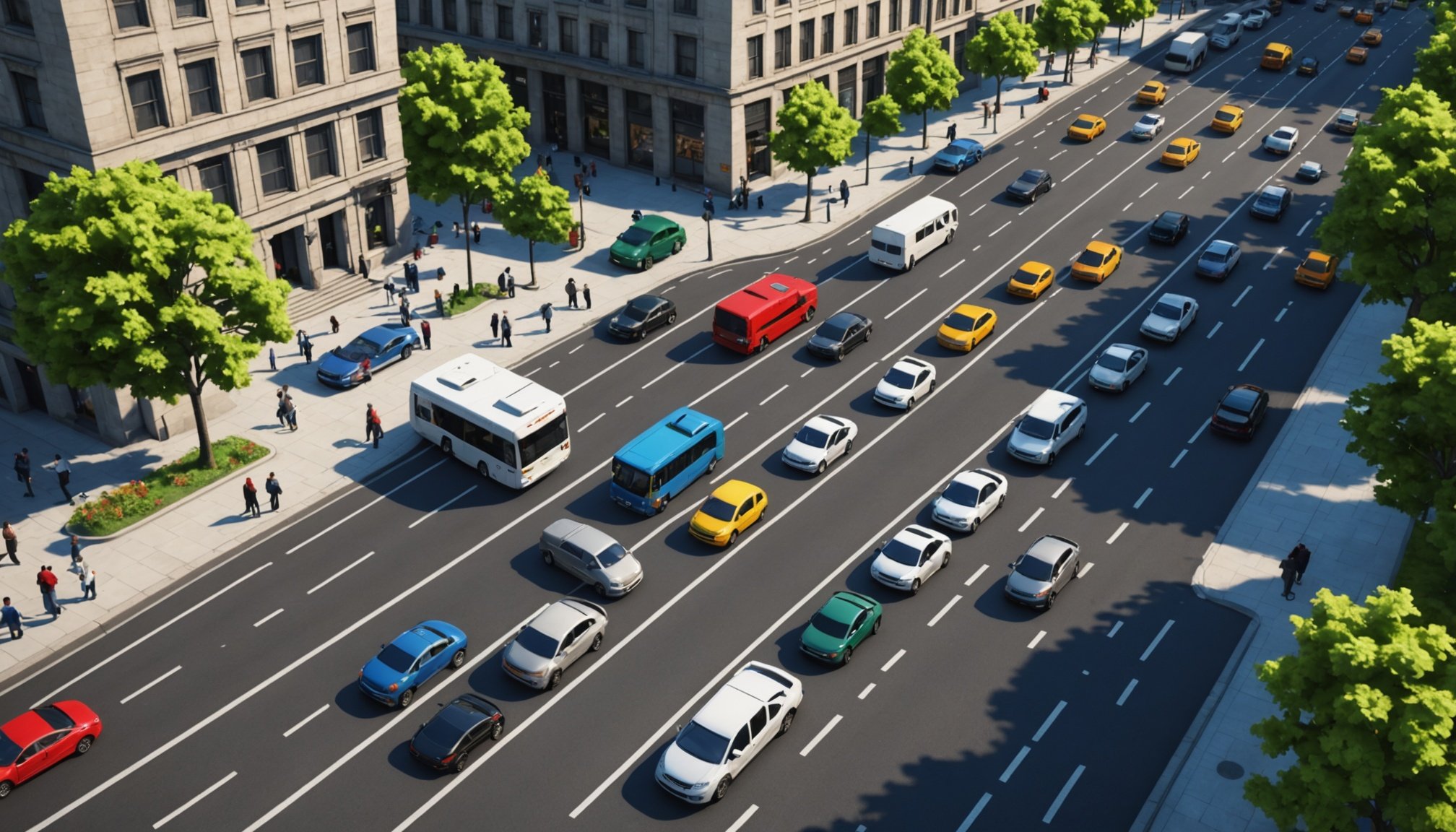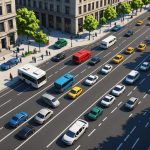Understanding Authentic Traffic Systems in Urban Simulation Games
In urban simulation games, authentic traffic design plays a pivotal role. It’s not just about aesthetics but an integral element of the gameplay experience. The term refers to creating realistic traffic systems that mimic real-world dynamics, including how roads, vehicles, and pedestrians interact. This authenticity enhances player engagement by offering challenges that require strategic planning and problem-solving.
Key Components of Traffic Systems
-
Roads: They form the framework of any urban simulation, dictating the flow and direction of traffic. Options for different road types, such as highways, lanes, or pedestrian paths, add depth to strategic planning.
Have you seen this : Mastering Realistic Forest Vegetation: Top Techniques for Immersive Exploration Games
-
Vehicles: Varied vehicle types – from bicycles to buses – impact traffic congestion and emissions, demanding players to make informed decisions.
-
Pedestrians: Their movement influences safety and accessibility, adding another layer of complexity to the urban simulation.
Also to read : Exploring the Impact of Blockchain Technology on Secure Transactions in Gaming
Influence on Gameplay Experience
A well-designed traffic system can make or break the overall gameplay experience. It tests players’ ability to manage resources and adapt to changes, thereby maintaining player interest. Successful navigation of these traffic systems results in a rewarding gameplay experience, encouraging players to develop comprehensive urban strategies.
Core Strategies for Designing Effective Traffic Systems
Developing influential traffic design strategies involves a detailed analysis of player behavior and its impact on traffic flow. Understanding how players interact with traffic systems can optimize player engagement. Observing common patterns such as frequent congestion points or potential hazards allows designers to tailor traffic mechanics that resonate with player expectations and desires.
Balancing realism and fun in traffic dynamics is another pivotal strategy. Players are more engaged when a game environment mirrors reality yet remains enjoyable. This balance can be achieved by incorporating believable traffic phases and unpredictable elements to keep game mechanics refreshing.
Dynamic traffic systems are integral to maintaining player interest. These systems adjust in response to game events or player decisions, creating a more immersive experience. For instance, simulating rush hours or implementing traffic lights that react to player actions contributes to a lively atmosphere.
To enhance player interaction and maintain interest, developers should continually refine these systems based on feedback and playtesting results. Iterative adjustments ensure that the implementation not only meets the game’s thematic and mechanical goals but also fosters a satisfying user experience through well-planned and executed traffic strategies.
Technical Approaches and Game Engine Recommendations
Exploring the technical aspects of game engine optimization is crucial for creating realistic urban simulations. The choice of the right tech stack, including a suitable game engine, can significantly influence the effectiveness of your traffic simulation techniques.
Popular Game Engines for Urban Simulation
Selecting a game engine that aligns with your simulation goals is fundamental. Many developers favour engines like Unity or Unreal Engine due to their vast plugin support and flexibility. These engines provide features that allow for extensive customization, which is vital for adapting to the varying demands of urban simulation projects.
Key Traffic Simulation Techniques
Developing competent traffic simulation techniques requires an understanding of models that replicate real-world scenarios. This involves using algorithms to mimic traffic flow, congestion, and vehicle behaviour efficiently. Techniques such as agent-based modelling and cellular automata are frequently employed to achieve realistic simulations.
Integration with Game Physics
A seamless interaction between physics and traffic systems is essential. Game engines offer advanced physics engines that help simulate real-world dynamics like friction, collisions, and momentum. It’s crucial to ensure that these systems interact coherently to avoid discrepancies that can detract from the simulation’s realism. By prioritizing these considerations, developers can create immersive and functional urban simulation experiences.
User Interface Tips for Traffic Management
Designing a user interface (UI) for traffic management requires careful consideration of various elements that can significantly impact player experience. User Interface Design should be intuitive, enabling players to easily navigate through traffic management tools without unnecessary complexity. This involves creating a player interface where actions are straightforward and feedback is clear.
One effective strategy is to incorporate visual aids and indicators. These tools can guide players in making informed decisions by highlighting critical areas, such as congestion points or routes with optimal flow. Simplicity and clarity in design help players quickly assimilate this information.
Feedback mechanisms are equally crucial in aiding player understanding of traffic dynamics. Providing real-time updates or alerts about changing conditions can foster a proactive approach to management. For example, dynamic color coding for traffic density can immediately draw attention to areas needing intervention.
To optimize the experience, a player interface should also adapt to varying levels of expertise, offering tutorials for beginners and advanced options for experienced users. By prioritizing usability and clarity, traffic management becomes more engaging and less daunting, ultimately offering a more rewarding gameplay experience.
Case Studies from Successful Urban Simulation Games
Studying urban simulation games provides valuable insights into crafting effective traffic systems and urban planning strategies. Titles like “Cities: Skylines” are often highlighted for their detailed approach to managing traffic congestion and public transit systems. By incorporating realistic scenarios and mechanics, these games teach players to balance road usage, improve public transport, and reduce bottlenecks.
One essential lesson from successful traffic systems is the need for strategic planning. Games often simulate challenges like traffic flow and peak hour gridlocks to encourage players to think ahead. For example, the use of dedicated bus lanes and bike paths has proven useful in many simulation models, demonstrating best practices from real-life urban planning strategies.
Moreover, successful urban simulation games typically prioritise the integration of community feedback. Developers frequently engage with their player base to refine game mechanics and enhance realism. This ongoing dialogue ensures the digital environments reflect evolving player expectations and preferences, such as the desire for eco-friendly transport options or improved zoning laws.
By examining these urban simulation examples, players and developers alike can glean essential insights into developing more efficient traffic systems and sustainable urban environments. Emulating these practices might inspire innovative solutions to real-world urban transportation challenges.
Common Pitfalls to Avoid in Traffic System Design
Designing traffic systems in game development often encounters design pitfalls that can detract from player engagement. One common mistake is overly complex systems that confuse players instead of guiding them. Ensuring the traffic system is intuitive is paramount; when developers overlook this, it results in traffic failures, leading to player frustration and disengagement.
Neglecting player engagement is another critical error. The traffic system should not just function; it should interact seamlessly with players, enhancing their game experience. If engagement is not prioritized, players may find the system mundane, which diminishes the overall game appeal.
Identifying Frequent Mistakes
- Lack of scalability: Traffic systems that can’t adapt to different game scales often fail when games evolve or expand.
- Insufficient testing: Ignoring rigorous testing can lead to significant traffic failures, as unanticipated player behaviors can reveal flaws.
- Poor optimization: Without optimization for performance, traffic systems may lag, impacting the game’s fluidity.
Enhancing Functionality
Mitigating these issues involves implementing player feedback loops and iterative testing phases. Incorporating design principles focused on user-centric approaches can transform a mundane system into an interactive, engaging feature. Developers should constantly refine and adapt traffic system architecture to align with player expectations.
Visual Aids and Enhancements
Visual Aids play a significant role in enriching user experience, particularly in gaming. Diagrams and Graphics assist players by simplifying complex information, such as traffic mechanics in strategy games. When players encounter visually intricate levels, break them down using diagrams and charts; this method allows for an intuitive understanding of key transitions and pathways. For instance, a well-drafted diagram can vividly illustrate congested traffic routes, offering players a clearer perception of possible solutions.
Incorporating Visual Aids in a game’s interface directly boosts players’ immersion. The connection between a player and the game environment is reinforced through impactful visuals, integrating them seamlessly with gameplay. This approach bridges gaps in understanding and engagement, elevating the overall gaming experience. Players can quickly comprehend complex game mechanics, leading to Enhanced Gameplay.
Existing titles frequently demonstrate the power of Diagrams and Graphics. For example, some games utilise intuitive traffic maps that allow players to devise strategic plans effectively. This Enhanced Gameplay experience is achieved through the strategic use of visual elements, encouraging players to explore and adapt without feeling overwhelmed. Through proper deployment of visual resources, developers can ensure players remain engaged and informed throughout their journey.











